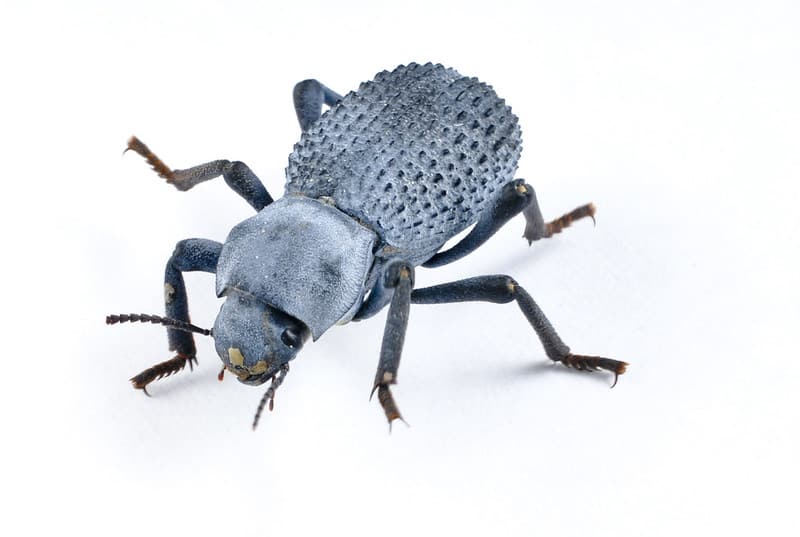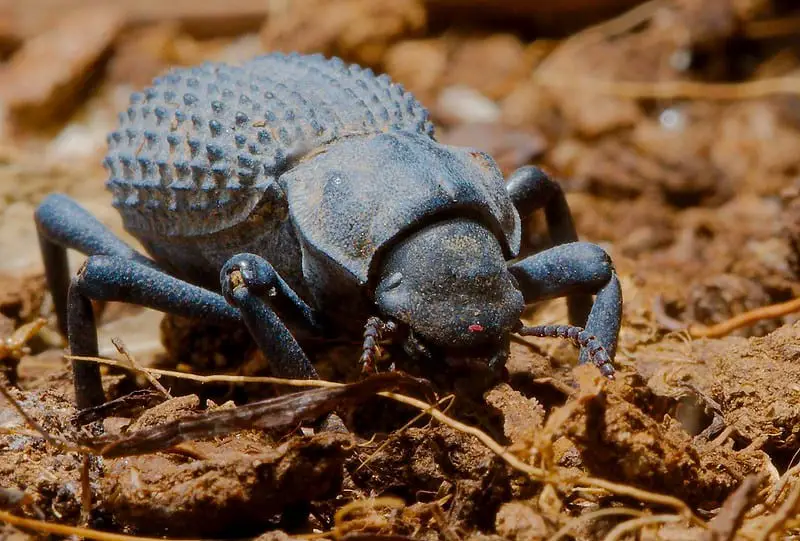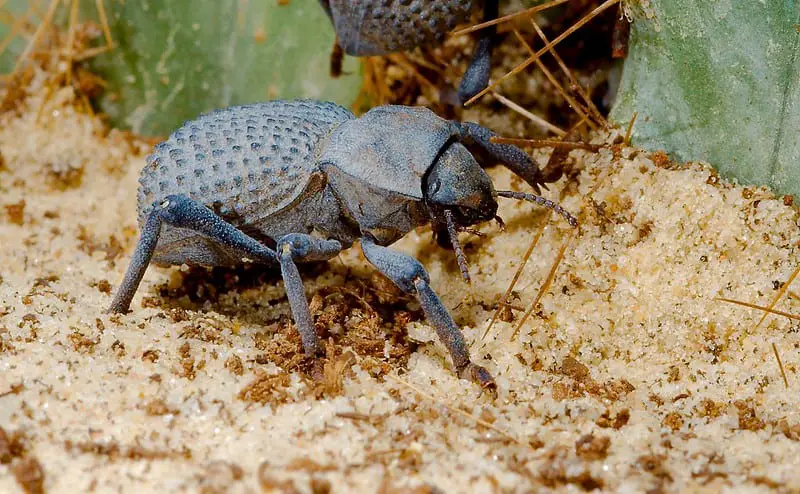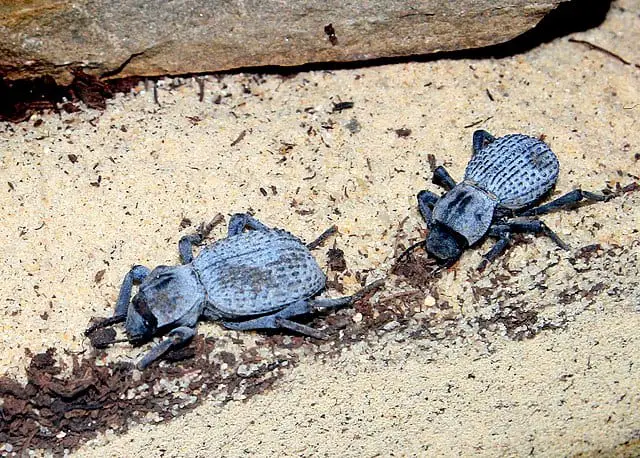The Blue Death Feigning Beetle (Asbolus verrucosus) is a darkling beetle native to the United States. It is an attractive pet, especially if you’re interested in having communal insects in a large enclosure.
They also have an interesting appearance, an intriguing defense mechanism, and they can live for over fifteen years!
If you’re interested in getting one of these amazing beetles as a pet, we’ve gathered all the information you need to see if it’s the best fit for you. We’ll also teach you exactly how to properly care for them.

Blue Death Feigning Beetle Care Sheet
| Name of species | Asbolus verrucosus |
| Family | Tenebrionidae |
| Common name | Blue Death Feigning Beetle |
| Category | Beetle |
| Type | Darkling beetles |
| Native location | Southwestern United States |
| Size | 0.71-0.83 inches (1.8-2.1 cm) |
| Diet | Decaying organic materials such as other insects and animals |
| Lifespan | 15+ years |
| Experience level | Beginner |
Blue Death Feigning Beetle overview
The Asbolus verrucosus is commonly named Blue Death Feigning Beetle thanks to its color and its most relevant defense mechanism; feigning death.
It also receives the name Blue Ironclad Beetle and Desert Ironclad Beetle because of its sturdy appearance.
These robust beetles can be found around the deserts in the Southwestern United States, especially in Mojave deserts and Sonoran deserts; however, due to the similar climates and closeness, it’s also possible to see them in Northern Mexico.
Appearance & Variations

The Desert Ironclad Beetle has a slim and flat body when compared to most beetles. It’s covered with a blue wax layer that protects it from direct sunlight, which gives the beetle its usual blue color.
It’s also covered with bumps in its elytra, giving it a warty appearance.
Dimorphism of this species between males and females is very light since males are only slightly smaller than females, and they have red hairs in their antennae. Other than that, they look the same, and it’s hard to tell them apart.
Price
Blue Feigning Death Beetles are common and inexpensive insects since they’re easy to find, care for, and breed.
Depending on where you get them and their size, you’ll find them for prices ranging between $13 and $26.
Behavior and Temperament
Despite the Blue Deth Feigning Beetle’s stern look, it’s a peaceful insect that means no harm to others. It’s not territorial, so you can house plenty of them in the same enclosure without losing any specimens.
This species is one of the few that could be housed with other species of arthropods. Some hobbyists have been able to accommodate them with ants and scorpions; it’s good as long as you don’t attempt to include natural predators such as tarantulas.
The BDFB has a strong jaw capable of strong bites, but it isn’t in its nature, so don’t be afraid of getting bit while handling one.
If you’re interested in handling these beetles, just be careful not to scare them or drop them. Sudden movements will likely trigger their defense mechanism, in which case they’ll feign death and lay down still.
At first, this will take hours to reverse, but as they grow used to being handled, the defense mechanism becomes shorter and more difficult to trigger because they start to realize that you’re not a threat to them.
Caring for a Blue Death Feigning Beetle

Temperature and Humidity
The desert is the best climate for a Blue Death Feigning Beetle. High temperatures and low humidity make them feel at home, so humidity levels should be below 20% and temperature between 70°F and 85°F.
It’s easier to achieve this climate in their enclosure if you place an iridescent lightbulb close to the tank, in which case it’s better if you turn it on twelve to sixteen hours each day to give them the day and night variation they’d experience in the desert.
Substrate
The Blue Death Feigning Beetle is used to the conditions of the desert. Therefore, sand is the best substrate you can provide it.
To be comfortable, this beetle doesn’t need more than two or three inches of substrate, but you should consider providing more if you want to keep it with other burrowing species.
Your BDFBs will mate if you keep them together, but they need the right kind of substrate if you want them to lay eggs. A mixture of coconut fiber and pesticide-free compost works best, so you should place some of this in the corner of the enclosure so they can breed comfortably.
Tank
Blue Death Feigning Beetles enjoy having enough places to hide. Place small rocks, pieces of bark, and branches in your tank to give them surfaces to climb and places to hide; just remember to place your rocks in a stable position, or else you’ll risk them toppling over and crushing your insects.
The tank also needs to have good ventilation, so make sure there are enough ventilation holes in the tank’s walls.
As for the size, you can have one or two specimens in a five-gallon tank if that’s what you’re looking for. However, if you’re interested in housing plenty of specimens and throwing more species into the mix, you should consider at least twenty gallons.
They’re very active insects, and even though they don’t fly, they’ll still enjoy having enough space to move around.
Watering
Blue Death Feigning Beetles don’t need a water dish in the tank. They’ll get their hydration from their food, so you should only place a water dish if you’re planning on getting other species that require one. Of course, providing them with a shallow water dish doesn’t hurt, but it’s not necessary for them to survive.
As for the substrate, you should spray the soil with water every one or two weeks to keep it at the right moisture level.
The only part of the substrate you should spray constantly is the breeding corner, where the coconut fiber and compost will mix with the water to provide an ideal environment for eggs.
Diet & Feeding
Blue Ironclad Beetles should get a food plate for their meals to make it easier to keep the enclosure clean.
They can survive long periods of time without eating, but it’s better if they’re fed two or three times per week.
As for their food, mealworms, crickets, and other small insects work as long as you kill them before serving them.
They can also eat high-protein fish food such as river shrimps. Beetle jelly is good for them too, and you can use homemade beetle jelly recipes if store-bought jelly goes out of your budget.
Lifespan & Health
The Blue Death Feigning Beetle has a remarkably long lifespan of up to 15 years. They’re surprisingly hardy creatures that can withstand a lot. If you care for them properly, it shouldn’t be a problem to keep them alive for extremely long periods of time because they don’t have much to fear in captivity.
The only things that can really threaten them in captivity are mold growth, parasites, and falls. To prevent these, make sure that you keep their enclosure clean and that you remove uneaten food in a timely manner.
In addition, make sure that the enclosure does not get too humid and that there is ample ventilation.
Lastly, make sure that you do not feed them wild-caught insects as those can contain parasites that can transfer to your beetle.
Fun Facts about the Blue Death Feigning Beetle
- The Blue Death Feigning Beetle gets its name from its most relevant survival mechanism. It’ll roll over its back and play dead if it feels threatened to dissuade predators. This way, they’re safe from territorial species that may want to fence them away. Also, movement-dependant predators such as tarantulas have trouble spotting them once they’re still, so it’s also effective against these threats.
- The BDFB gets the “verrucosus” in Asbolus verrucosus from its appearance. It’s made with the Latin words verrūca + -ōsus, and it stands for warty or covered with warts.
- Blue Death Feigning Beetles get their blue color from a protective layer of wax covering their bodies. This layer is washed away when there’s high humidity in the environment; therefore, your BDFB will stop being blue and will instead turn black if the enclosure isn’t dry enough.
Final words: Is the Blue Death Feigning Beetle right for you?
The Blue Death Feigning Beetle is a great choice for beginner and advanced hobbyists. They can be an easygoing companion for new hobbyists, with an interesting look and amazing longevity.
Experienced hobbyists are often drawn to this species because it gives them the possibility of having a large and complex tank with different species that include BDFBs.
If this beetle species is not right for you, there are plenty of others to choose from. I suggest taking a look at these Beetles:
I’m sure that by doing plenty of research you can find the ideal species for you!
- How Long Do American Eskimo Dogs Live? Important Factors and Care Tips - September 29, 2023
- Do American Bulldogs Need Grooming? Essential Tips and Care Guidelines - September 29, 2023
- Do Bengal Cats Enjoy Playing? Essential Tips for Keeping Them Active - September 29, 2023
